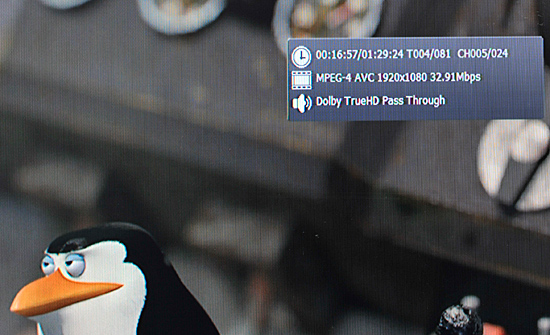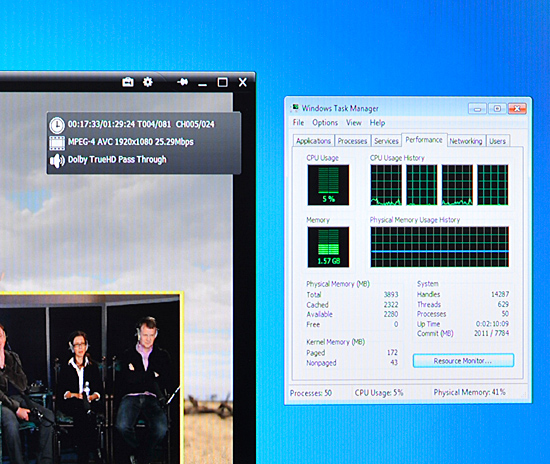The Real Conroe Successor: Clarkdale & All You Need to Know about Westmere
by Anand Lal Shimpi on September 24, 2009 6:00 PM EST- Posted in
- CPUs
Bitstreaming TrueHD/DTS-HD MA: Yep, Here too
The Radeon HD 5870 was the first graphics card to properly support bitstreaming of high definition Blu-ray audio codecs. Clarkdale/Arrandale is the second.
These CPUs come with an on-package GPU and that GPU supports the appropriate protected audio path to enable bitstreaming of Dolby TrueHD and DTS-HD MA. Of course 8-channel LPCM output is also still an option.
If you remember the G45 launch, Intel had serious issues enabling 8-channel LPCM output, HDCP and H.264 decode acceleration in general. I grilled Intel on what was going to make this round different and they are much more confident in their abilities.
They've increased the number of receivers they test with (originally it was at a whopping two, now they're up to…7). They've also expanded their test scenarios as well. The combination of the two, Intel believes, will result in a fully functional set of HTPC features at launch.
The first time I went by Intel's Clarkdale demo, Intel couldn't get bitstreaming working. A day later I got an email telling me to drop by again - they fixed it.

I got to see TrueHD bitstreaming from a Clarkdale system to a Sony receiver. I also confirmed that full two stream decode acceleration was working:

Intel had it working with Arcsoft's player, but is working with all of the major software vendors to hopefully enable full support on everything. Intel does seem to be taking this much more seriously than with G45.

The Clarkdale launch is still a couple of months away so there is definitely time for Intel to work out the kinks.
This is a serious feature. The fact is that in a couple of years every single PC shipped will have the ability to bitstream these audio codecs without any additional hardware. We're finally getting there folks.










96 Comments
View All Comments
jordanclock - Friday, September 25, 2009 - link
I see you're privy to data we are not seeing. Could you please share where you received this information that moving the memory controller to another chip ON THE SAME SOCKET will somehow cause pre-IMC memory latencies? We'd all like to see some actual numbers instead of sensationalist guesses.KaarlisK - Friday, September 25, 2009 - link
I remembered reading about it somewhere.It was from the benchmark here. http://global.hkepc.com/3878/page/5#view">http://global.hkepc.com/3878/page/5#view
Though the latency in this review is higher than Core 2's, which makes it suspect.
As to the why, there are smarter people than me who could answer whether there's any impact from locating the other die on the CPU package or in the chipset.
GeorgeH - Thursday, September 24, 2009 - link
Hopefully more major manufacturers will offer Mini-ITX motherboards this generation. It's nice to see at least one Intel board, but if 775 is any indication it'll be almost ridiculously feature poor.I also hope PS and case manufacturers are paying attention - the current crop of mini-ITX options is pitiful.
Mr Perfect - Saturday, September 26, 2009 - link
Absolutely.I'm impressed that the mITX has what looks to be an x16 PCIe slot on it though. In the past, Intel was always throwing a PCI or x1 slot on them. I think they where afraid that people would stop buying the bigger, more expensive boards. I know I would have.
Hopefully Anand will take a good hard look at this sector.
tomoyo - Friday, September 25, 2009 - link
No kidding! There's a total lack of good mini-itx boards with undervolting features and only one server raid case for mini-itx at all. It's sad because I'm sure a ton of people would love to make a small DIY raid nas system and not deal with the low end parts and lack of OS choice in pre-built nas systems.Aquila76 - Thursday, September 24, 2009 - link
I was going to build an HTPC soon, but if this can really bitstream TrueHD & DTS-MA on a single, low-power chip then I can wait. Next year is going to kill my wallet, but at least I can start saving now!mgl888 - Thursday, September 24, 2009 - link
What's gonna happen after 22nm? 10nm?When are we gonna hit a brick wall and what's Intel plan to do next?
Quantum computing?
Zink - Thursday, September 24, 2009 - link
It looks like there is going to be a big delay after 22nm because the thickness of certain layers in the transistors can not be scaled thinner.Check out 16nm too: http://en.wikipedia.org/wiki/22_nanometer">http://en.wikipedia.org/wiki/22_nanometer
jwilliams4200 - Thursday, September 24, 2009 - link
Each die shrink generation decreases the gate length by a factor of the square root of two (0.707), so that the die area decreases by a factor of two every shrink. To answer your questions, the gate lengths to expect are: 45nm, 32nm, 22nm, 16nm, 11nm, 8nm, 5.6nm ...As to how the lower ones can be achieved, or whether they will be achieved, I will not venture a guess.
CurseTheSky - Thursday, September 24, 2009 - link
Thank you for clarifying that. I always wondered how they determined what the next process size would be. It seemed like they picked arbitrary numbers out of a hat, but now I see that:65 / 2^(1/2) = 45.96
45 / 2^(1/2) = 31.82
32 / 2^(1/2) = 22.63
etc.